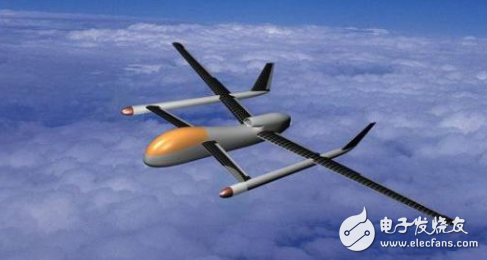With the development of technology, the scope of application of drones has become wider and wider, and the style of drones is also increasing. At present, solar drones developed in China are also beginning to be applied. Solar drones are based on solar energy. The source of energy, the future clearance time can be several months to several years, and the flight altitude is 20,000 to 30,000 meters. With it, we no longer have to worry about the life of the drone!
In recent years, with the accelerated development of adjacent space, the development of drone technology has also ushered in a major breakthrough. The new drone product of solar drone is receiving extensive attention from all over the world. In the future, as countries make new progress in the research and development of related technologies for solar drones, they will be expected to leverage their diverse advantages to promote the commercialization process.

At 19:45 on November 5, the Long March 3B carrier rocket was successfully ignited. The first and second satellites of the Beidou No. 3 navigation system were successfully put into orbit by "one arrow and two stars". China's Beidou navigation system was officially comprehensive. Open the curtain of global networking.
Since the new century, with the advancement of science and technology, human beings have made new progress in the development and utilization of space, and more and more satellites are outside the earth. As the space space becomes "crowded", the vast potential of the adjacent space is gradually being discovered by humans.
Great value in the development of adjacent spaceLooking up at the moon and looking down at the earth, what kind of experience is this? In the past, to experience such a scenario, it was necessary to travel to space, which required enormous manpower, material resources and financial resources. Today, a region where humans know little about it - the adjacent space is receiving widespread attention.
The adjacent space, also known as near space, generally refers to a space area of ​​20 km to 100 km above sea level, which is a transitional space between a space of more than 100 km and an aerospace space of less than 20 km. The adjacent space is an ideal area for providing all-weather high-speed wireless network coverage, high-resolution geographic mapping, high-altitude traffic command, high-precision monitoring of the ground, scientific research and new space services for sky-high definition imaging.
The exploration of the adjacent space has attracted great attention and attention. Multinational governments, scientific research institutions and high-tech giants have strengthened their scientific exploration of the adjacent space.
Solar drone speeds up "conquest" adjacent spaceIn recent years, with the rapid development of solar drones, this emerging technology product has become an important “nugger guest†in the adjacent space. In fact, solar-powered drone research began in the world in the 1980s, initially in the United States. Later, the United Kingdom, Germany, China, Russia and other countries have also joined, and have increased the development of solar drones. Investing, trying to gain a competitive advantage in this field, in order to seize the dominant space in the adjacent space.
The United States has developed very early in the field of solar drones, represented by Facebook and Google's two Internet giants. Not long ago, Facebook's Aquila drone successfully completed the second flight test, getting rid of the shadow of the first test flight failure, which means that Facebook's plan to use solar drones to provide Internet services to remote areas has made a solid step forward. step. In addition, Google, another big US giant, launched the SkyBender project, which is currently being tested at the US Spaceport in the desert near Las Cruces, New Mexico, USA.
Not long ago, according to the Russian company Ravochkin Scientific Research and Production Co., the company's first solar high-altitude drone LA-252 "é¹³" developed by the company will also test flight before the end of the year. The drone belongs to a spacecraft nearby, and similar satellites rely on solar energy to operate at an altitude of 15 to 22 kilometers that civilian aircraft cannot reach. The company's general manager Sergei Lemesevski said that the aircraft basically confirmed the design performance parameters of the drones except for high-altitude flights during the tests conducted from July to September this year. The company plans to obtain a test flight at Kuban airport and plans to organize a test flight from November to December.
In May of this year, the new rainbow solar drone independently researched and developed by China Aerospace Science and Technology Corporation's 11th Institute completed a near-space flight test in a certain place in the northwest, which was a complete success and attracted a lot of attention. This lightweight solar drone is also a "big head" with a wingspan of 45 meters. According to Shi Wen, chief engineer of the new rainbow solar drone, the key technologies and equipment of this drone are all localized.
Solar drone applications have diverse advantagesThe reason why solar drones have gained widespread attention around the world lies in their enormous application advantages.
Due to its high flying height, strong maneuverability and long air time, the solar drone has the potential to become a “quasi-satellite†in the future. It can be used as an aerial platform, partially replacing the communication satellite function, and providing users with no regional restrictions. "Companion" network access service. For example, solar drones can provide communication services for remote areas. When natural disasters such as earthquakes cause damage to ground communication facilities, the airborne base stations equipped with solar drones can also provide emergency communications.
Moreover, compared with traditional chemical fuel-based aircraft, solar drones are energy-efficient and environmentally friendly, and do not pollute the atmosphere.
In addition, high-altitude solar drones can also be equipped with high-resolution cameras for land confirmation, real estate registration, urban mapping, land and resources surveys, disaster assessment and many other fields. People have every reason to believe that with the further development of solar drone material technology and endurance, the development of adjacent space will enter a new stage, and the dream of “sustainable flight†will also be realized.
ZGAR AZ Mesh Vape Pods 1.0
ZGAR electronic cigarette uses high-tech R&D, food grade disposable pods and high-quality raw material. A new design of gradient our disposable vape is impressive.We equip with breathing lights in the vape pen and pods.
Our team has very high requirements for product quality, taste allocation and packaging design. Designers only use Hong Kong designers, e-cigarette liquid only imports from the United States, materials are food grade, and assembly factory wants medical grade without ground workshop.
We offer best price, high quality Mesh Pods,Pod System Vape,Pods Systems Touch Screen,Empty Pod System, Pod Vape System,Disposable Pod device,Vape Pods to all over the world.


Pod Systems Vape And Smoke,Vape Pod System Device,ZGAR AZ Mesh Vape Pods 1.0 Pod System Vape Kit,Pod System Mini Vape Pod
ZGAR INTERNATIONAL(HK)CO., LIMITED , https://www.zgarette.com